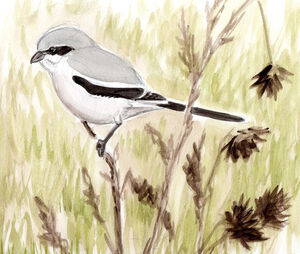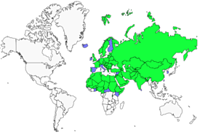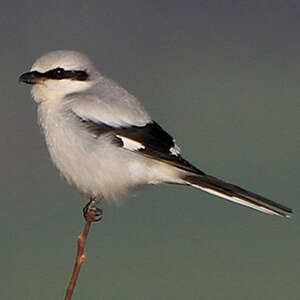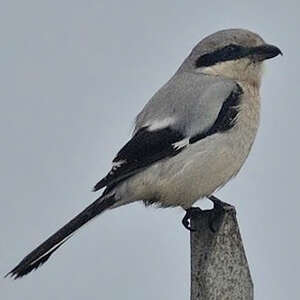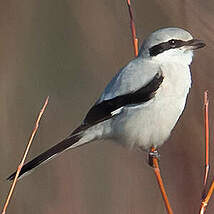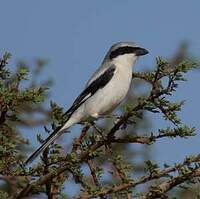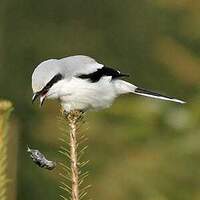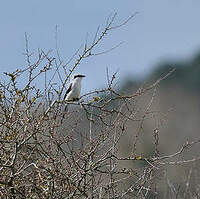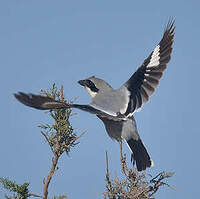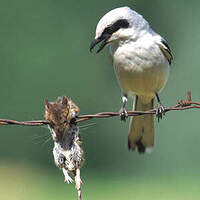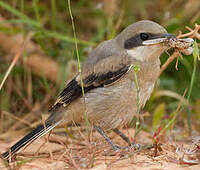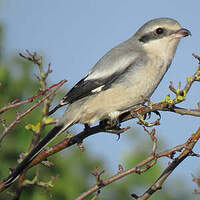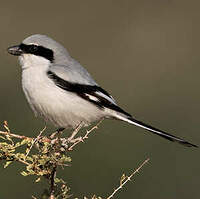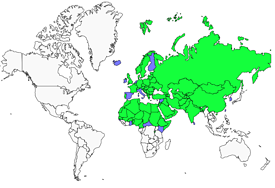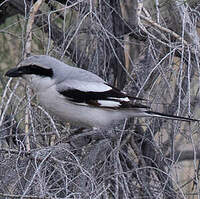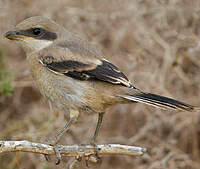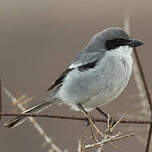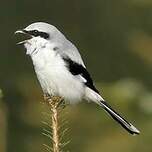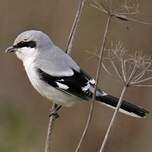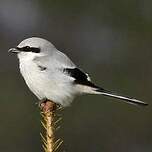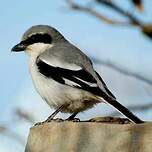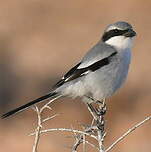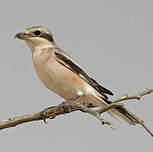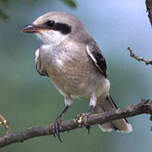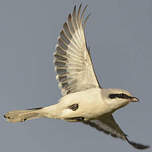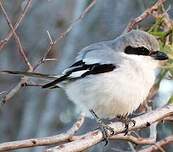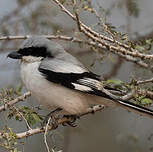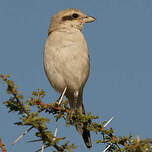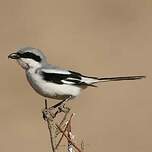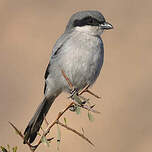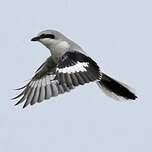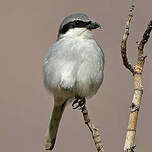Great Grey Shrike
Lanius excubitor - Pie-grièche grise
Identification
The taxon Great Grey Shrike is a quite complex one which has been recently revised. Currently 12 subspecies, quite different from one another, are recognized in its wide range. You can get an idea by browsing the species gallery. I would like to emphasize here the nominal taxon excubitor which occupies Europe.
The Great Grey Shrike is a large shrike, approximately the size of the Blackbird. There is practically no sexual dimorphism. The female can sometimes be distinguished from the male by the light vermiculation of the chest plumage, similar to that of a 1st year bird, but the beak is definitely black.
The upper parts, from the beak to the tail, are light grayish, sometimes with a bluish tone maybe due to the sky. The rump and above the tail are a bit paler. The scapulars form a light band between the gray mantle and the black wing. A clear black band starts from the beak and includes the dark eye. Between this mask and the crown, a faint white eyebrow is perceptible which joins a white frontal band. The beak, not very thick, is black and hooked at the tip.
The lower parts are white from the beak to the tail. The wings and tail are black. The first ones show a white spot at the base of the primaries and white at the tip of the inner primaries. The tail has its outer rectrices white and still white on the two adjacent pairs which is diminishing. This can clearly be seen on the bird in flight. The short, clawed legs are black.
In the southeast of France where it rarely ventures, you should avoid confusing it with the local taxon, the Southern Shrike, which has the lower parts light grayish with a slightly vinous tone. Possible confusion also with a young Shrike with a rosy chest which does not have the adult's black forehead. It is necessary to look at the beak.The one with the pink breast is shorter, thicker and less hooked.
Subspecific information 12 subspecies
- Lanius excubitor excubitor (n, c and e Europe, nw Siberia)
- Lanius excubitor homeyeri (se Europe and sw Siberia)
- Lanius excubitor koenigi ()
- Lanius excubitor algeriensis ()
- Lanius excubitor elegans ()
- Lanius excubitor leucopygos ()
- Lanius excubitor aucheri ()
- Lanius excubitor theresae ()
- Lanius excubitor buryi ()
- Lanius excubitor uncinatus ()
- Lanius excubitor lahtora ()
- Lanius excubitor pallidirostris ()
Foreign names
- Pie-grièche grise,
- Alcaudón norteño,
- picanço-real-nortenho,
- Raubwürger,
- nagy őrgébics,
- Klapekster,
- Averla maggiore,
- varfågel,
- Varsler,
- strakoš veľký,
- ťuhýk šedý,
- Stor Tornskade,
- isolepinkäinen,
- botxí septentrional,
- Grásvarri,
- srokosz (europejski),
- lielā čakste,
- veliki srakoper,
- Серый сорокопут,
- ヨーロッパオオモズ,
- 西方灰伯劳,
- 北方灰伯勞,
Voice song and cries
Its song consists of simple repeated phrases such as pli pli pli... plu i plu i plu i... psisisisi psisisisi psisisisi plilili plilili plilili that can be heard from afar, with numerous individual variations. It also has the ability to mimic sounds. The alarm call is a kouehhhh with a sound similar to that of a jay.
Habitat
During the breeding season, the Great Grey Shrike looks for open spaces with some trees and bushes, and a moderate level of vegetation.
Behaviour character trait
Generally, one will discover the Great Grey Shrike perched high up on a bush or shrub. It is then hunting and attentive to its environment.
Of course, our presence bothers it since it is quite a sensitive bird. And it expresses its discontent with its alarm call when it is on a breeding territory.The Great Grey Shrike uses different hunting techniques depending on the available prey. Most of the time, it perches on a woody plant, surveying the surroundings, ever on the lookout to surprise its prey. Less frequently, it practices hovering flight to better identify small prey or prey coming out of a burrow. Once the predation is done, any remaining, uneaten victims are impaled in thorny bushes for lean days. Such is the way of all shrikes.
Flight
The Great Grey Shrike has a direct, undulating flight, with short bursts of energetic wingbeats. Morphologically, it is not meant for long migratory journeys. Its migrations are often creeping as they say.
It often hovers a few metres off the ground to get a better look at a prey spotted from a watchpost. This flight, body vertical, well displaying the white on wings and tail, is typical.
Dietfeeding habits
The Great Grey Shrike's diet is clearly carnivorous. For the nominate subspecies, the ideal prey is a small mammal of the field mouse type, often numerous and even teeming, and easy to capture with the legs and kill with the beak.
Field mice can make up to 90% of the biomass consumed. However, these prey populations often fluctuate and the shrike must adapt and turn to other taxa. Large insects, especially beetles and orthopterans, young birds and nestlings are also excellent dishes in its diet. When the opportunity presents itself, lizards and small amphibians are also taken. Other invertebrate taxa, arachnids, myriapods, and oligochaetes are among the occasional prey. The diet varies greatly from one subspecies to another depending on the habitat.Reproduction nesting
The Great Grey Shrike is monogamous and highly territorial during the breeding season. It starts early in the south of its range, from March to the end of May in the north.
The male defends the territory with its voice. The nest, built by the couple, is placed high in a tree - at least for the nominate subspecies - and necessarily lower for tropical subspecies. When there is no other possibility, it can be built in a dense shrub. It is made of composite materials such as grass, stems, twigs and roots, and is lined with feathers. In French plains in April, the female lays 6-7 (3-9) pale blue-grey eggs, densely but lightly spotted with grey-brown, which take 14-18 days to hatch. The young fledge at the age of 6 weeks, 19-20 days after hatching, and leave the territory a week later. There is no second clutch for this species, only a replacement clutch in case of loss of the first.Geographic range
Great Grey Shrike has a wide distribution in the western Palearctic at temperate and boreal latitudes, from the Atlantic seaboard to central Russia and Mongolia to the south of India. It is also present in the northern half of Africa (Maghreb and Saharan regions) and in the Arabian Peninsula. It is both a partial migrant and resident according to the 12 subspecies. Breeding birds from Scandinavia undertake a withdrawal movement to the southwest to Western Europe and those from Siberia and Mongolia to the south of the continent, Anatolia, the shores of the Black and Caspian seas and the steppes of Asia, from Ukraine to Kazakhstan. Birds in tropical latitudes are largely residents as are those in the Maghreb.
Threats - protection
IUCN conservation status
concern
in the Wild
threatened
evaluated
Generally speaking, the Great Grey Shrike is not threatened due to its large distribution area and the criteria used to compile the Red List. Nevertheless, the nominal subspecies has notably declined in recent decades in the southern part of its range. For example, I know that it has become much rarer on the plateaus of the Jura for no obvious reason.
Put simply, the Great Grey Shrike is one of many victims of the intensification of agricultural practices. Indeed, in temperate Europe, it is linked to an extensive agricultural landscape dominated by livestock farming and this has drastically changed.
Sources of information
- IOC World Bird List (v13.2), Gill, F and D Donsker (Eds). 2023.
- Les passereaux d'Europe, tome 2, P. Géroudet, M. Cuisin
- SHRIKES A Guide to the Shrikes of the World, Lefranc Norbert, Worfolk Tim
- Shrikes bush-shrikes, Tony Harris
- Avibase, Lepage Denis
- Birds of the World, The Cornell Lab of Ornithology
- xeno-canto, Sharing bird sounds from around the world,
Other sources of interest
 Specification sheet created on
25/07/2023 by Jean François
Specification sheet created on
25/07/2023 by Jean FrançoisTranslation by AI Oiseaux.net
published: 10-12-2020 - Updated: 26-12-2020
© 1996-2024 Oiseaux.net
- Accipitriformes
- Aegotheliformes
- Anseriformes
- Apodiformes
- Apterygiformes
- Bucerotiformes
- Caprimulgiformes
- Cariamiformes
- Casuariiformes
- Charadriiformes
- Ciconiiformes
- Coliiformes
- Columbiformes
- Coraciiformes
- Cuculiformes
- Eurypygiformes
- Falconiformes
- Galliformes
- Gaviiformes
- Gruiformes
- Leptosomiformes
- Mesitornithiformes
- Musophagiformes
- Nyctibiiformes
- Opisthocomiformes
- Otidiformes
- Passeriformes
- Pelecaniformes
- Phaethontiformes
- Phoenicopteriformes
- Piciformes
- Podargiformes
- Podicipediformes
- Procellariiformes
- Psittaciformes
- Pterocliformes
- Rheiformes
- Sphenisciformes
- Steatornithiformes
- Strigiformes
- Struthioniformes
- Suliformes
- Tinamiformes
- Trogoniformes

